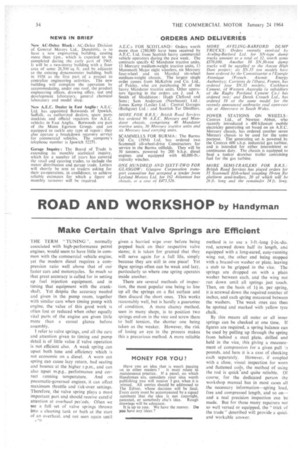ROAD AND WORKSHOP by Handyman
Page 56

If you've noticed an error in this article please click here to report it so we can fix it.
Make Certain that Valve Springs are Efficient
THE TERM "TUNING ", normally associated with high-performance petrol engines, would seem to have little in common with the commercial vehicle engine, yet the modern diesel requires a compression ratio well above that of our faster cars and motorcycles. So much so that great accuracy is called for in setting up fuel injection equipment, and in timing that equipment with the crankshaft, Yet despite the accuracy needed and given in the pump room. together with similar care when timing pump with engine, the value of this good work is often lost or reduced when other equally vital parts of the engine are given little more than a casual glance before assembly.
I refer to valve springs, and all the care and attention given to timing and pump detail is of little value if valve operation is not efficient also. A weak spring can Upset both tune and efficiency which is not economic on a diesel. A worn out spring can cause lazy return, bad seating and bounce at the higher r.p,m., and can also upset m.p.g.. performance and correct cunning temperature, And on pneumatic-governed engines, it can affect maximum throttle and Eck-over settings. Therefore, the valve spring plays a most important part and should receive caref:11 attention at overhaul per:ods. Often we see a full set of valve springs thrown into a cleaning tank or bath at the start of an overhaul, and not seen again until given a hurried wipe over before being popped back on their respective valve stems; it is taken for granted that they will serve again for a full life, simply because they are still in one piece! Yet thcse springs often can be weak and lazy, particularly so where one spring operates inside another.
There are several methods of inspection, the most popular one being to line up all the springs on a flat surface and then discard the short ones. This works reasonably well, but is hardly a guarantee of condition. A more chancy method, seen in many shops, is to position two springs end-on in the vice and screw them to half tension, the shorter one being taken as the weaker. However, the risk of losing an eye in the process makes this a precarious method, A more reliable
method is to use a 3-It-long
rod, screwed down half its length, and equipped with a long-eared, easy-running wing nut, the other end being stopped with a brazed-on washer or plate, leaving a stub to be gripped in the vice. The springs are dropped on with a plain washer between each, and the wing nut run down until all springs just touch. Then, on the basis of 1* in. per spring, it is screwed down the required number of inches, and each spring measured between the washers. The weak ones can then be -spotted and marked with yellow tyre chalk.
By this means all outer or all inner springs can be checked at one time. If figures are required, a spring balance can be used by pulling up through the spring from behind a steel plate, drilled and held in the vice, this giving a measurement of compression for a given pull :1 pounds, and here it is a case of checking each separately. However, if coupled with a close, visual inspection for worn and flattened coils, the method of using the rod is quick and quite reliable. Of course, for the dedicated person the workshop manual has in most cases all the necessary information—spring load, free and compressed length, and so on— and a real precision inspection can be made. But for those many repairers not so well versed or equipped, the "trick of the trade" described will provide a quick and workable answer,
























































































































